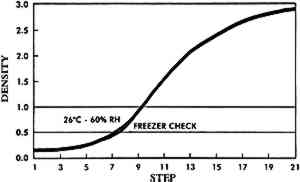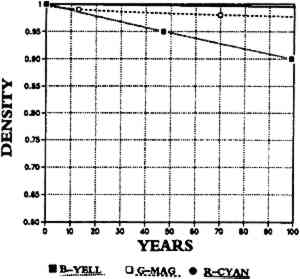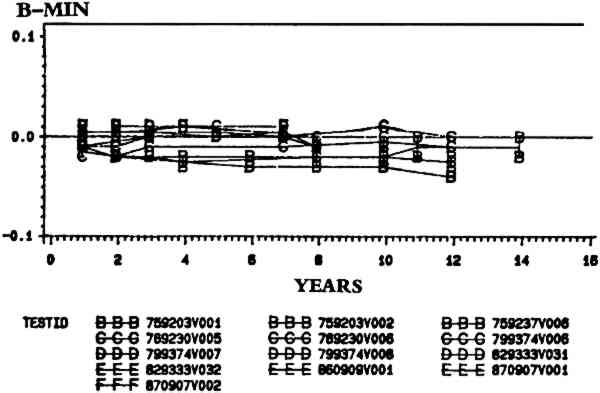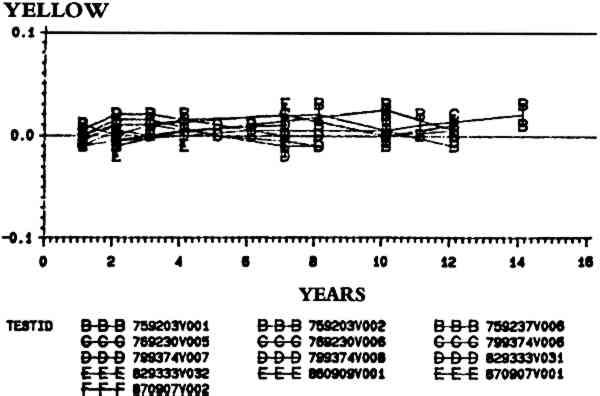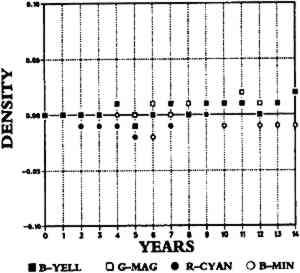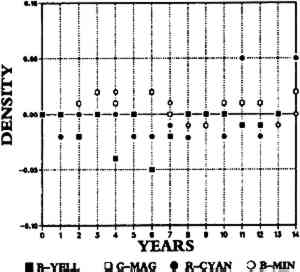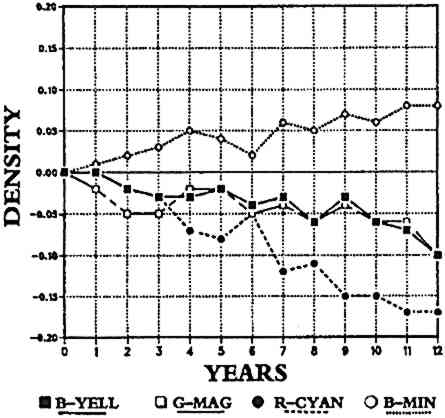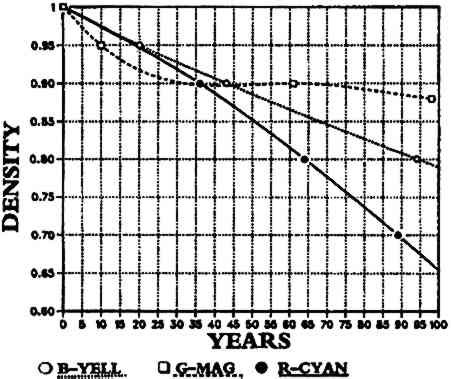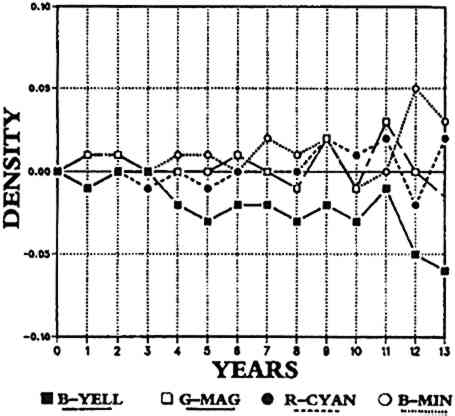NATURAL AGING OF PHOTOGRAPHSSTANTON ANDERSON, & ROBERT ELLISON
4 EXPERIMENTAL RESULTSData on only four products will be presented due to limitations of space. We do not yet have data on our most current products now being sold in the trade because of the obvious lag in time required to collect the data. The four products reported on here are one black-and-white film, KODAK PANATOMIC-X, and three color products, KODACHROME Film, KODAK EKTACOLOR 37 RC Paper, and Kodak Dye Transfer Paper. These products were marketed for many years, and large quantities of processed product still exist in public and private collections today as photographic images. The color products have retained the same color dye sets for many years. In the case of KODACHROME and Dye Transfer Paper, we are using the same basic dye sets even today. 4.1 KODAK PANATOMIC-X FILMThe image compositions of some of our products have not significantly changed over time. For example, many of our black-and-white films form silver images that have some common features. Furthermore, some of our most long-term data are on black-and-white products. For example, figure 5 shows 19 years of keeping at 26�C/60% RH for KODAK PANATOMIC-X Film. The results demonstrate what is typical for properly processed black-and-white images of the silver halide variety through conventional wet processes (using fixing solutions). Such materials are known to be very stable, even archival under proper keeping.
The term “archival” has been used historically to denote photographic products in the highest category of permanence (Adelstein 1978). The term has been reserved for certain black-and-white films, properly stored and processed. It has never been used for color products or black-and-white papers. The black-and-white film must form a silver image, be on a specified stable support (polyester base), and be processed and stored according to the specifications of the American National Standards Institute (ANSI). If any of these criteria are not met, the product is not considered archival. ANSI is now considering eliminating the term “archival” in favor of a designation called “long-term.” 4.2 KODACHROME FILMSFor KODACHROME films we have been predicting, in many tests over the years (Eastman Kodak Company 1988), that it will take more than 100 years for a 10% change for any of the image dyes, neutrals, or D-min areas at 24�C/40% RH or 24�C/60% RH (fig. 6). Furthermore, we have examined old transparencies kept by their owners for several decades, and they still retain good color balance and density. With this knowledge, we were eager to compare the results of our natural aging
Figures 7–9 show the raw data for 13 separate emulsions that were tracked for up to 14 years of keeping. Plots are shown for B-min and for D-min corrected image dye (for the yellow) at a status A density of 1.0. An examination of the data will show only small fluctuations from zero and no significant trends. The raw data from the control show the magnitude of variability that is not image-stability related. A look at results for the other conditions shows similar behavior.
The magnitude of fluctuation is not surprising, since the Image Stability Technical Center requires in excess of .04 density change before differences are taken as real in evaluating products. This requirement is based on years of experience and the known variability in densitometry and handling. The fact that the plots are flat (i.e., show no slopes) confirms the expected overall stability of KODACHROME Films. The results are further elucidated in figures 10–12, which show scatter plots of the average data for all the density changes and conditions. Natural aging confirms our predictions from Arrhenius tests and actual use: KODACHROME is very stable to dark-keeping.
4.3 KODAK EKTACOLOR 37 RC PAPERAnother product that has had much use over the years is an older paper, KODAK EKTACOLOR 37 RC Paper. It contains the same dye set as its replacement, KODAK EKTACOLOR 74 Paper. Current papers such as KODAK EKTACOLOR Plus Paper are predicted to be several times more stable due to some fundamental changes in the composition of the cyan dye. Our Arrhenius testing on KODAK EKTACOLOR 37 RC Paper, as shown in table 1, predicts that cyan is the least stable image dye. Based on 44 individual Arrhenius tests run over many years, it is predicted that it will take 8.49 (SD 2.24) years for a 10% loss of cyan dye at 24�C/40%RH. We have much less information at 60% RH since this Arrhenius method was implemented much later. At 24�C/60% RH we predict (based on only six tests) that it will take 8.50 (SD 0.55) years for 10% loss of the cyan dye. Our predictions are that the other dyes and D-min are much more stable, requiring several decades for a � 0.10 change in status A reflection density. TABLE 1 PREDICTED DARK STABILITY OF KODAK EKTACOLOR 37 RC PAPER FROM ARRHENIUS TESTING In the same manner as the data previously shown for KODACHROME, we have generated 12 plots for each of the three conditions and four density levels. The three conditions are −23�C, 24�C/40% RH, and 26�C/60% RH; the density levels are B-min, cyan, magenta, and yellow patched at 1.0. For lack of space we will not show these data. However, some clear trends are noted when we examine the line plots of the averages from the raw data (fig. 13). Specifically, we are averaging the data points at each time interval for all the jobs at each of the reference density levels. In particular
There also appears to be some evidence of blue density increases at both humidities, indicating that a stain is being formed. The gain in blue densities in the 24�C/40% RH samples (not shown) is not large enough to be significant. The amount of increase in the 26�C/60% RH data (fig. 13) is surprising since the Arrhenius tests (at 24�C/60%RH) do not
4.4 KODAK DYE TRANSFER PAPERThe last product we will describe is KODAK Dye Transfer Paper, a product which has traditionally been known for its good dark stability. The natural aging verifies this reputation as shown in figure 15. Twelve plots of raw data have been generated, and these are summarized by showing only the scatter plots of the average values. With the possible exception of some small losses in yellow dye at 26�C/60% RH, the natural aging shows no significant evidence of density changes. For years the Arrhenius predictions for Dye Transfer Paper have given predictions of more than 50 years for a 0.10 change in any of the dyes or minimum densities.
Although the general results seem consistent, it is interesting to note the high variability on the test data from this product. The reason for the variability is not known; it may be due to the nature of the dye sets, the thickness and lack of flatness of the paper support, or other variables that might affect densitometry but do not relate to the actual stability of the image, such as operator errors in positioning samples or physical defects such as spots, scratches, fingerprints, or dust. |
